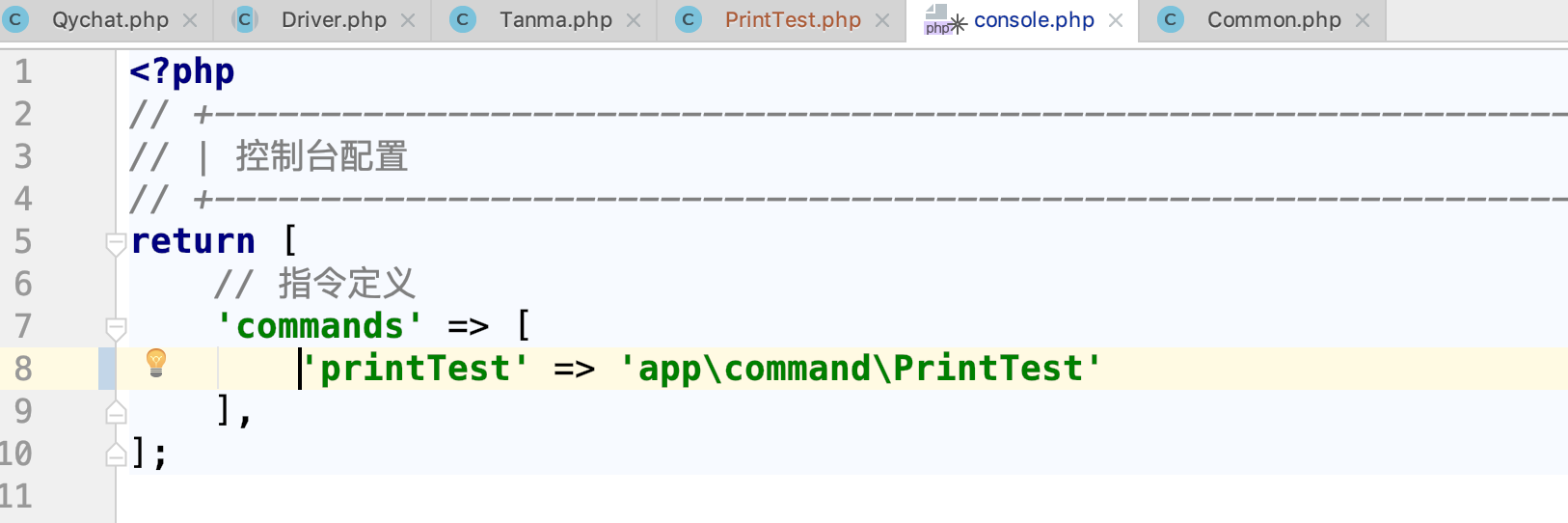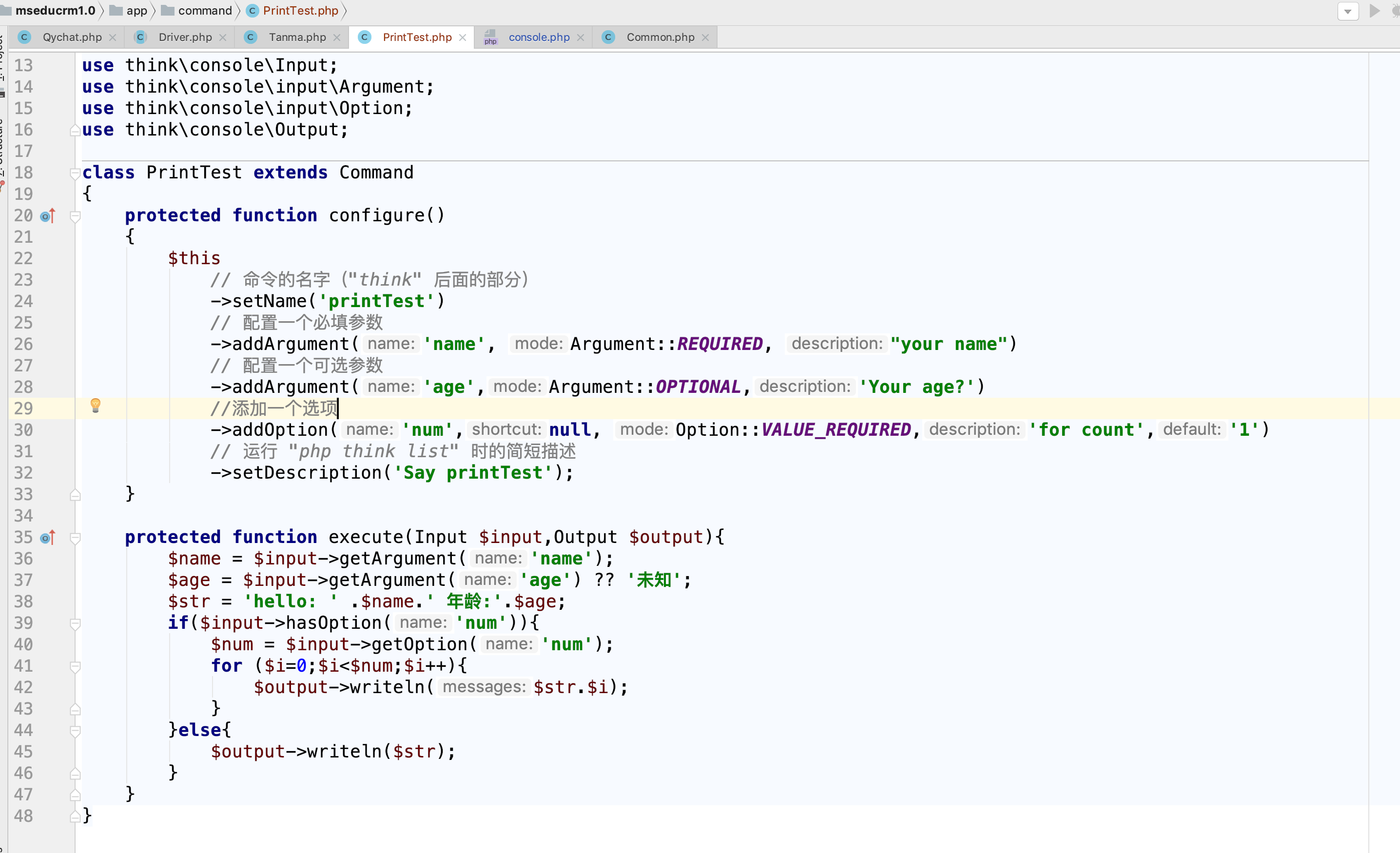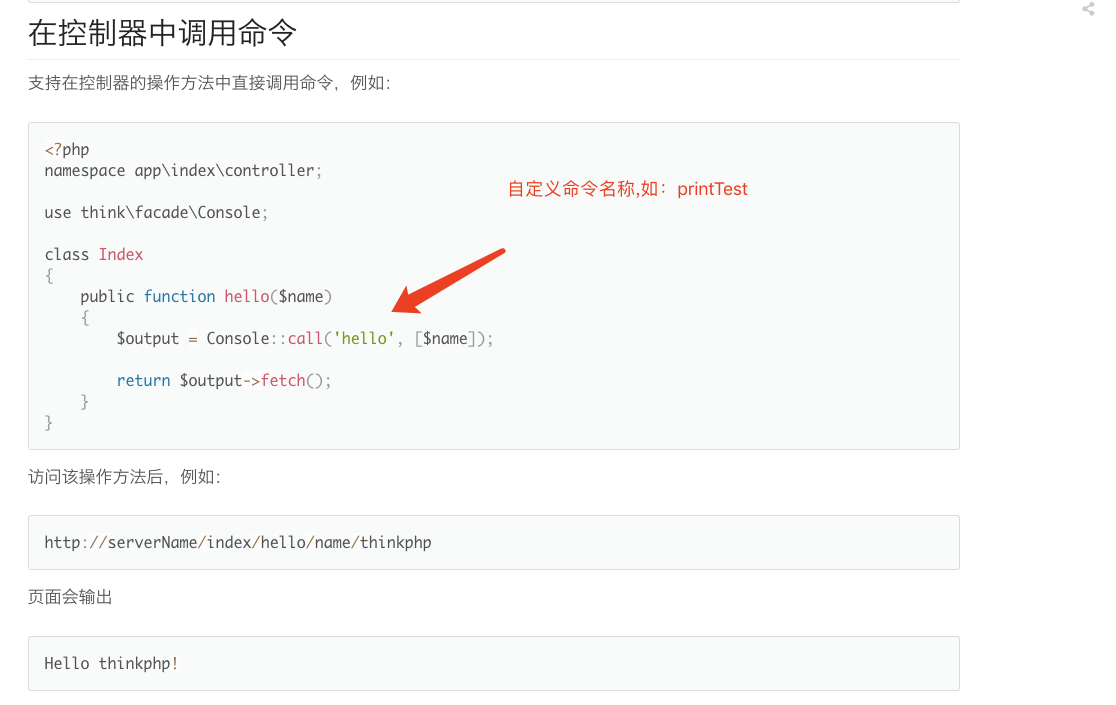步驟:
執行命令:php think?hello xiaoming zhangsan
1\. command文件夾中創建自定義指令php class文件,且繼承 think\\console\\Command類
2\. 包含?configure、execute方法
3\. config/console.php 添加命令

#使用控制臺參數
#參數是字符串,多個參數由空格分隔,并且跟在命令名稱的后面。參數是有順序的,而且可以是可選的或必須的。例如,添加一個可選的 last\_name 參數到命令中,并且令 name 參數必填:
#使用控制臺參數
#參數是字符串,多個參數由空格分隔,并且跟在命令名稱的后面。參數是有順序的,而且可以是可選的或必須的。例如,添加一個可選的 last\_name 參數到命令中,并且令 name 參數必填:
代碼:

??注意看參數和選項的調用區別
方式一:控制臺調用
?命令:php think printTest liujie 20 --num 2
?
?方式二:控制器中調用

# 控制臺輸出(參數和選項)
命令行最有趣的部分,就是你可以利用參數(`arguments`)和選項(`options`)。參數和選項,能夠讓你從終端(`terminal`)向命令(`command`)動態地傳入信息。
## 使用控制臺參數
參數是字符串,多個參數由空格分隔,并且跟在命令名稱的后面。參數是有順序的,而且可以是可選的或必須的。例如,添加一個可選的 last\_name 參數到命令中,并且令 name 參數必填:
~~~php
<?php
namespace app\console;
use think\console\Command;
use think\console\Input;
use think\console\input\Argument;
use think\console\Output;
class CreateUser extends Command
{
// ...
protected function configure()
{
$this
// 命令的名字("think" 后面的部分)
->setName('app:create-user')
// 配置一個參數
->addArgument('name', Argument::REQUIRED, 'Do you like ThinkPHP')
->addArgument('last_name', Argument::OPTIONAL, 'Your last name?')
// 運行 "php think list" 時的簡短描述
->setDescription('Creates new users.')
// 運行命令時使用 "--help" 選項時的完整命令描述
->setHelp("This command allows you to create users...");
}
protected function execute(Input $input, Output $output)
{
// ...
}
}
~~~
現在你可以在命令中訪問 last\_name 參數:
~~~php
<?php
namespace app\console;
use think\console\Command;
use think\console\Input;
use think\console\input\Argument;
use think\console\Output;
class CreateUser extends Command
{
// ...
protected function configure()
{
$this
// 命令的名字("think" 后面的部分)
->setName('app:create-user')
// 配置一個參數
->addArgument('name', Argument::REQUIRED, 'Who like ThinkPHP ?')
->addArgument('last_name', Argument::OPTIONAL, 'Your last name?')
// 運行 "php think list" 時的簡短描述
->setDescription('Creates new users.')
// 運行命令時使用 "--help" 選項時的完整命令描述
->setHelp("This command allows you to create users...");
}
protected function execute(Input $input, Output $output)
{
$text = 'Hi ' . $input->getArgument('name');
$lastName = $input->getArgument('last_name');
if ($lastName) {
$text .= ' ' . $lastName;
}
$output->writeln($text . '!');
}
}
~~~
~~~sql
$ php think app:create-user kitty
Hi kitty!
$ php think app:create-user kitty cat
Hi kitty cat!
~~~
也可以讓參數接收“值的列表”(用空格分割)。但只有最后一個參數才能是列表:
~~~kotlin
$this
// ...
->addArgument(
'names',
Argument::IS_ARRAY,
'Who like ThinkPHP (separate multiple names with a space)?'
);
~~~
要使用列表,指定任意多的名字即可:
~~~sql
$ php think app:create-user Jim Kitty Lucy
~~~
你可以訪問到作為數組的 names 參數:
~~~bash
$names = $input->getArgument('names');
$text = '';
if (count($names) > 0) {
$text .= ' ' . implode(', ', $names);
}
~~~
有三種參數類型可用:
| 參數類型 | 說明 |
| --- | --- |
| `Argument::REQUIRED` | 參數必填。如果不提供,則命令不運行 |
| `Argument::OPTIONAL` | 參數可選,因此可以忽略 |
| `Argument::IS_ARRAY` | 參數可以包含任意多個值。因此,它必須使用在參數列表中的最后一個 |
你可以像下面這樣同時使用?`IS_ARRAY`?和?`REQUIRED`?以及?`OPTIONAL`?:
~~~php
$this
// ...
->addArgument(
'names',
InputArgument::IS_ARRAY | InputArgument::REQUIRED,
'Who like ThinkPHP (separate multiple names with a space)?'
);
~~~
## 使用命令行選項
和參數不同,選項是沒有順序之分的 (也就是說你可以按任意順序指定它們) ,指定選項是用兩個中杠 (如:`--key`)。
選項?*始終*?是可選的,而且可以被設置為接收一個值 (如:`--dir=src`) ,或者是一個布爾值而不需要值 (如:`--key`)。
例如,向一個“信息在一行之內應該被輸出指定的次數”的命令中添加一個新的選項:
~~~kotlin
$this
// ...
->addOption(
'num',
null,
Option::VALUE_REQUIRED,
'How many messages should be print?',
1
);
~~~
接下來,使用這個命令來多次輸出信息:
~~~bash
for ($i = 0; $i < $input->getOption('iterations'); $i++) {
$output->writeln($text);
}
~~~
完整示例:
~~~php
<?php
namespace app\console;
use think\console\Command;
use think\console\Input;
use think\console\input\Argument;
use think\console\input\Option;
use think\console\Output;
class CreateUser extends Command
{
// ...
protected function configure()
{
$this
// 命令的名字("think" 后面的部分)
->setName('app:create-user')
// 配置一個參數
->addArgument('name', Argument::REQUIRED, 'Who like ThinkPHP ?')
// 配置一個選項
->addOption(
'num',
null,
Option::VALUE_REQUIRED,
'How many messages should be print?',
1
);
}
protected function execute(Input $input, Output $output)
{
$text = 'Hi ' . $input->getArgument('name');
for ($i = 0; $i < $input->getOption('num'); $i++) {
$output->writeln($text);
}
}
}
~~~
現在,運行命令時,你可以可選地指定一個?`--num`?了:
~~~sql
# 不提供 --num,使用的默認值是(1)
$ php think app:create-user kitty
Hi kitty
$ php think app:create-user kitty --num=7
Hi kitty
Hi kitty
Hi kitty
Hi kitty
Hi kitty
Hi kitty
Hi kitty
# 選項的順序是任意的的
$ php think app:create-user kitty --num=7 --key
$ php think app:create-user kitty --key --num=7
$ php think app:create-user --key --num=7 kitty
~~~
> 你還可以為選項聲明一個“以單個中杠開頭”的單字符的快捷方式,比如?`-n`:
~~~kotlin
$this
// ...
->addOption(
'num',
'n',
Option::VALUE_REQUIRED,
'How many messages should be print?',
1
);
~~~
選項 支持四種類型:
| 選項類型 | 說明 | 示例 |
| --- | --- | --- |
| `Option::VALUE_IS_ARRAY` | 此選項可接收多個值 | \--dir=/foo --dir=/bar |
| `Option::VALUE_NONE` | 此選項不接受輸入的值 | \--key |
| `Option::VALUE_REQUIRED` | 此選項的值必填,但選項本身仍然是可選的 | \--num=7 |
| `Option::VALUE_OPTIONAL` | 此選項的值可有可無 | \--key 或 --key=value |
你可以像下面這樣同時使用?`VALUE_IS_ARRAY`?和?`VALUE_REQUIRED`?或?`VALUE_OPTIONAL`?:
~~~php
$this
// ...
->addOption(
'animals',
null,
Option::VALUE_REQUIRED | Option::VALUE_IS_ARRAY,
'Which animals do you like?',
array('cat', 'dog')
);
~~~
> 當你創建命令時,使用選項并令其可選地接受一個值,它是不受約束的。但是,當這個選項并沒有具體值 (`command --language`) ,或者它根本沒被使用 (`command`) 的時候,你是沒有辦法做到區分這些情況的。這兩種情況下,此選項所收到的值都是?`null`。
- thinkphp6執行流程(一)
- php中use關鍵字用法詳解
- Thinkphp6使用騰訊云發送短信步驟
- 路由配置
- Thinkphp6,static靜態資源訪問路徑問題
- ThinkPHP6.0+ 使用Redis 原始用法
- smarty在thinkphp6.0中的最佳實踐
- Thinkphp6.0 搜索器使用方法
- 從已有安裝包(vendor)恢復 composer.json
- tp6with的用法,表間關聯查詢
- thinkphp6.x多對多如何添加中間表限制條件
- thinkphp6 安裝JWT
- 緩存類型
- 請求信息和HTTP頭信息
- 模型事件用法
- 助手函數匯總
- tp6集成Alipay 手機和電腦端支付的方法
- thinkphp6使用jwt
- 6.0session cookie cache
- tp6筆記
- TP6(thinkphp6)隊列與延時隊列
- thinkphp6 command(自定義指令)
- command(自定義指令)
- 本地文件上傳
- 緩存
- 響應
- 公共函數配置
- 七牛云+文件上傳
- thinkphp6:訪問多個redis數據源(thinkphp6.0.5 / php 7.4.9)
- 富文本編輯器wangEditor3
- IP黑名單
- 增刪改查 +文件上傳
- workerman 定時器操作控制器的方法
- 上傳文件到阿里云oss
- 短信或者郵箱驗證碼防刷代碼
- thinkphp6:訪問redis6(thinkphp 6.0.9/php 8.0.14)
- 實現關聯多個id以逗號分開查詢數據
- thinkphp6實現郵箱注冊功能的細節和代碼(點擊鏈接激活方式)
- 用mpdf生成pdf文件(php 8.1.1 / thinkphp v6.0.10LTS )
- 生成帶logo的二維碼(php 8.1.1 / thinkphp v6.0.10LTS )
- mysql數據庫使用事務(php 8.1.1 / thinkphp v6.0.10LTS)
- 一,創建過濾IP的中間件
- 源碼解析請求流程
- 驗證碼生成
- 權限管理
- 自定義異常類
- 事件監聽event-listene
- 安裝與使用think-addons
- 事件與多應用
- Workerman 基本使用
- 查詢用戶列表按拼音字母排序
- 擴展包合集
- 查詢用戶數據,但是可以通過輸入用戶昵稱來搜索用戶同時還要統計用戶的文章和粉絲數
- 根據圖片的minetype類型獲取文件真實拓展名思路
- 到處excel
- 用imagemagick庫生成縮略圖
- 生成zip壓縮包并下載
- API 多版本控制
- 用redis+lua做限流(php 8.1.1 / thinkphp v6.0.10LTS )
- 【thinkphp6源碼分析三】 APP類之父, 容器Container類
- thinkphp6表單重復提交解決辦法
- 小程序授權
- 最簡單的thinkphp6導出Excel
- 根據訪問設備不同訪問不同模塊
- 服務系統
- 前置/后置中間件
- 給接口api做簽名驗證(php 8.1.1 / thinkphp v6.0.10LTS )
- 6實現郵箱注冊功能的細節和代碼(點擊鏈接激活方式)
- 使用前后端分離的驗證碼(thinkphp 6.0.9/php 8.0.14/vue 3.2.26)
- 前后端分離:用jwt+middleware做用戶登錄驗證(php 8.1.1 / thinkphp v6.0.10LTS )
- vue前后端分離多圖上傳
- thinkphp 分組、頁面跳轉與ajax
- thinkphp6 常用方法文檔
- 手冊里沒有的一些用法
- Swagger 3 API 注釋
- PHP 秒級定時任務
- thinkphp6集成gatewayWorker(workerman)實現實時監聽
- thinkphp6按月新增數據表
- 使用redis 實現消息隊列
- api接口 統一結果返回處理類
- 使用swoole+thinkphp6.0+redis 結合開發的登錄模塊
- 給接口api做簽名驗證
- ThinkPHP6.0 + UniApp 實現小程序的 微信登錄
- ThinkPHP6.0 + Vue + ElementUI + axios 的環境安裝到實現 CURD 操作!
- 異常$e
- 參數請求驗證自定義和異常錯誤自定義
